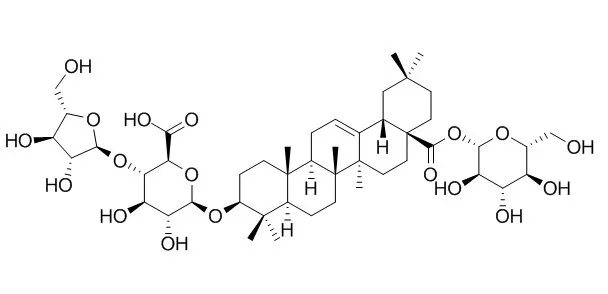| In vitro: |
| Planta Med. 2006 Feb;72(3):193-8. | | Suppression of Fas-mediated apoptosis of keratinocyte cells by chikusetsusaponins isolated from the roots of Panax japonicus.[Pubmed: 16534721] | Activity-guided fractionation led to the isolation of Chikusetsusaponin IV, Chikusetsusaponin IVa, chikusetsusaponin V and polysciasaponin P5 as the active ingredients.
METHODS AND RESULTS:
Of these compounds, Chikusetsusaponin IV, was most active when applied at a concentration of 12.5 microg/mL. The intracellular hallmark events of apoptosis such as DNA fragmentation and chromatin condensation were significantly reduced by the treatment with Chikusetsusaponin IV. The apoptotic cell death of Jurkat cells was also suppressed by treatment with the active saponins.
CONCLUSIONS:
These results suggest that the use of Chikusetsusaponin IV, Chikusetsusaponin IVa, chikusetsusaponin V, polysciasaponin P5, or a crude extract of P. japonicus containing these saponins is expected to relieve cutaneous symptoms caused by excessive apoptotic cell death in the skin through the Fas/FasL pathway. | | Biomed Res . 2010 Apr;31(2):155-9. | | Inhibition of human renin activity by saponins[Pubmed: 20460744] | | Abstract
Renin is the most important enzyme in the renin-angiotensin system. Our previous study led to the identification of soyasaponin I, the first renin inhibitor isolated from soybean. In the present study, the effects of saponins and sapogenols on human renin activities were investigated. Soyasaponins I and II, glycyrrhizin, monoglucuronyl glycyrrhetic acid (MGGA), Chikusetsusaponin IV, and Kochia scoparia fruit saponins (momordins) were found to inhibit renin activity. On the other hand, sapogenols (soyasapogenol B and glycyrrhetic acid), saikosaponins b2 and c, and ginsenoside Rb(1) had no effect on renin activity. These results clearly indicate that the 3-O-beta-dglucopyranosiduronic moiety in saponins (glucuronide saponin) is essential for renin inhibition. |
|






 Cell. 2018 Jan 11;172(1-2):249-261.e12. doi: 10.1016/j.cell.2017.12.019.IF=36.216(2019)
Cell. 2018 Jan 11;172(1-2):249-261.e12. doi: 10.1016/j.cell.2017.12.019.IF=36.216(2019) Cell Metab. 2020 Mar 3;31(3):534-548.e5. doi: 10.1016/j.cmet.2020.01.002.IF=22.415(2019)
Cell Metab. 2020 Mar 3;31(3):534-548.e5. doi: 10.1016/j.cmet.2020.01.002.IF=22.415(2019) Mol Cell. 2017 Nov 16;68(4):673-685.e6. doi: 10.1016/j.molcel.2017.10.022.IF=14.548(2019)
Mol Cell. 2017 Nov 16;68(4):673-685.e6. doi: 10.1016/j.molcel.2017.10.022.IF=14.548(2019)